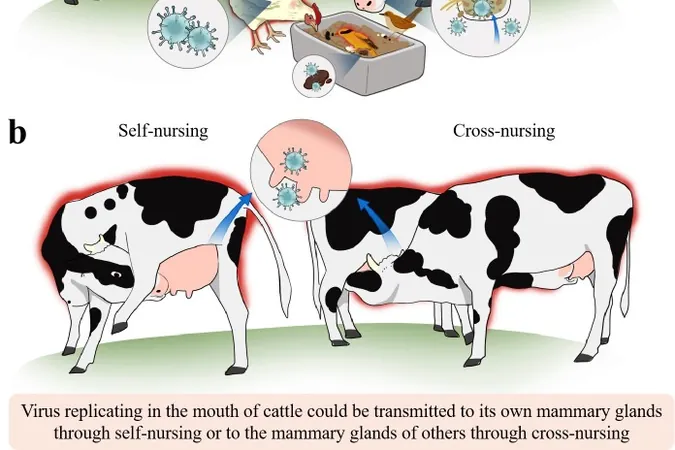
How Plants Outmaneuver Gravity to Find Water in Drought
2025-05-19
Author: Arjun
Plants on the Move: The Fight for Survival
Despite being rooted in place, plants are masters of adaptation. When the going gets tough—like during a drought—they dig deeper for resources, altering the very patterns of their roots. A groundbreaking study from researchers at the Institute of Science and Technology Austria (ISTA) and Northwest A&F University in China reveals how plants cleverly navigate their surroundings to find water when it becomes scarce.
Roots: Breaking the Rules of Gravity
Normally, plant roots grow downwards due to gravity, a process called gravitropism. This ensures they dig deep enough to absorb essential nutrients. However, during periods of drought, plants switch gears. They leave behind their downward trajectory and actively pursue moisture, utilizing a behavior known as hydrotropism.
The Secret behind Hydrotropism: MIZ1 Protein
The study reveals that a pivotal protein named MIZ1 plays a crucial role in this strategic shift. While previous studies focused predominantly on how plants react to light and gravity, this research uncovers MIZ1’s ability to help plants prioritize water over gravitational pull, essential for developing drought-resistant crops in the future.
Testing the Effects of Gravity Loss
In a fascinating experiment, researchers eliminated gravity's influence using a rotating platform, allowing them to observe roots in a gravity-free environment. The results were striking: without the weight of gravity, roots bent much more dramatically towards water sources.
MIZ1's Role in Root Orientation
Identified decades ago, MIZ1 has been recognized as a key regulator of hydrotropism. When compared to standard Arabidopsis plants, those lacking MIZ1 struggled to shift their growth pattern towards moisture, continuing their downward course instead.
Simulating Drought to Understand Responses
Researchers simulated drought conditions by applying sorbitol to the plant roots, mimicking dry soil. In response, normal Arabidopsis plants effectively redirected their roots towards moisture. Conversely, mutants without MIZ1 remained stubbornly directed downwards, missing vital water pockets—showcasing MIZ1's importance in their survival.
How Drought Alters Root Behavior
The astonishing influence of MIZ1 extends to other proteins, specifically the PIN proteins that guide auxin, a key growth hormone. Under normal conditions, auxin flows downward, aligning with root growth. However, in drought conditions, MIZ1 upends this polarity, allowing roots to bend towards moisture rather than being anchored by gravity.
Revolutionizing Agricultural Practices
Understanding how plants prioritize water could lead to revolutionary advancements in agriculture, particularly in developing drought-resistant crops. By enhancing hydrotropism through targeted manipulation of MIZ1 and PIN proteins, plants could be better equipped to thrive in arid environments.
Future Research Directions
While this study sheds light on the hydrotropic mechanisms at play, many questions remain. How exactly does MIZ1 sense moisture at a cellular level? What interactions occur between MIZ1 and other regulatory proteins? Additionally, extending this research beyond Arabidopsis to vital crops like wheat and maize could unlock practical solutions for enhancing drought resistance in agriculture.
Embracing Change in Agriculture
As climate change continues to challenge our agricultural systems, understanding how plants adeptly navigate water scarcity will become increasingly important. The interplay between MIZ1 and PIN proteins could herald a new era in crop resilience, offering pathways to enhance food security in an unpredictable climate. The insights from this study, published in the *Proceedings of the National Academy of Sciences*, could ultimately change the way we cultivate our crops, ensuring they can withstand even the harshest of droughts.





 Brasil (PT)
Brasil (PT)
 Canada (EN)
Canada (EN)
 Chile (ES)
Chile (ES)
 Česko (CS)
Česko (CS)
 대한민국 (KO)
대한민국 (KO)
 España (ES)
España (ES)
 France (FR)
France (FR)
 Hong Kong (EN)
Hong Kong (EN)
 Italia (IT)
Italia (IT)
 日本 (JA)
日本 (JA)
 Magyarország (HU)
Magyarország (HU)
 Norge (NO)
Norge (NO)
 Polska (PL)
Polska (PL)
 Schweiz (DE)
Schweiz (DE)
 Singapore (EN)
Singapore (EN)
 Sverige (SV)
Sverige (SV)
 Suomi (FI)
Suomi (FI)
 Türkiye (TR)
Türkiye (TR)
 الإمارات العربية المتحدة (AR)
الإمارات العربية المتحدة (AR)